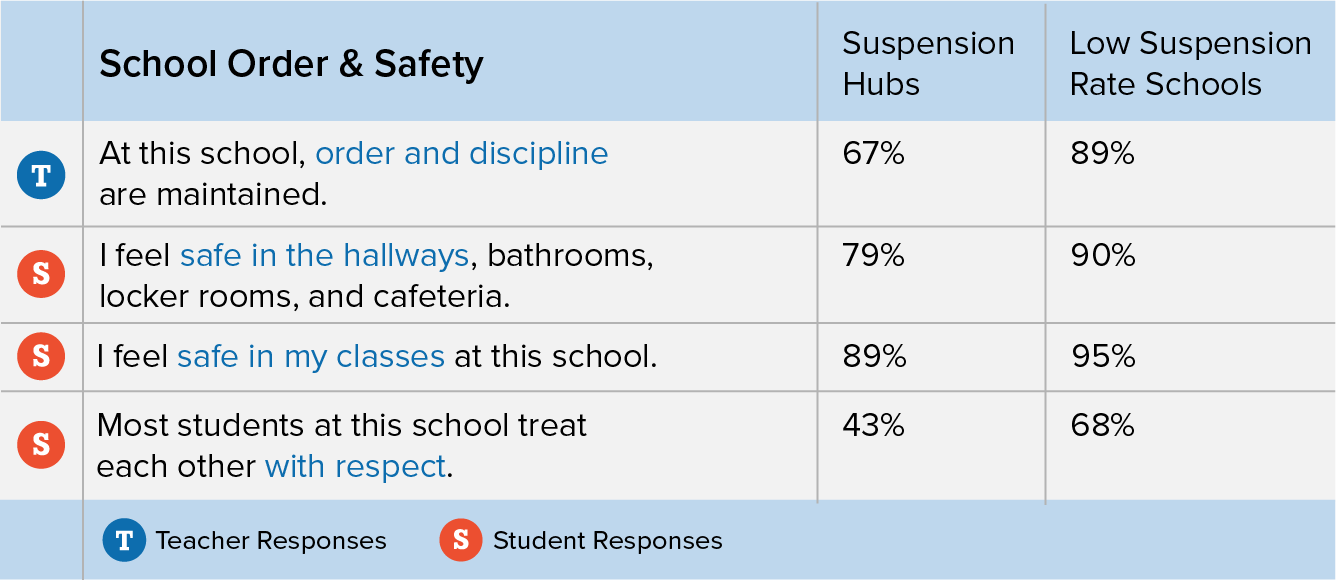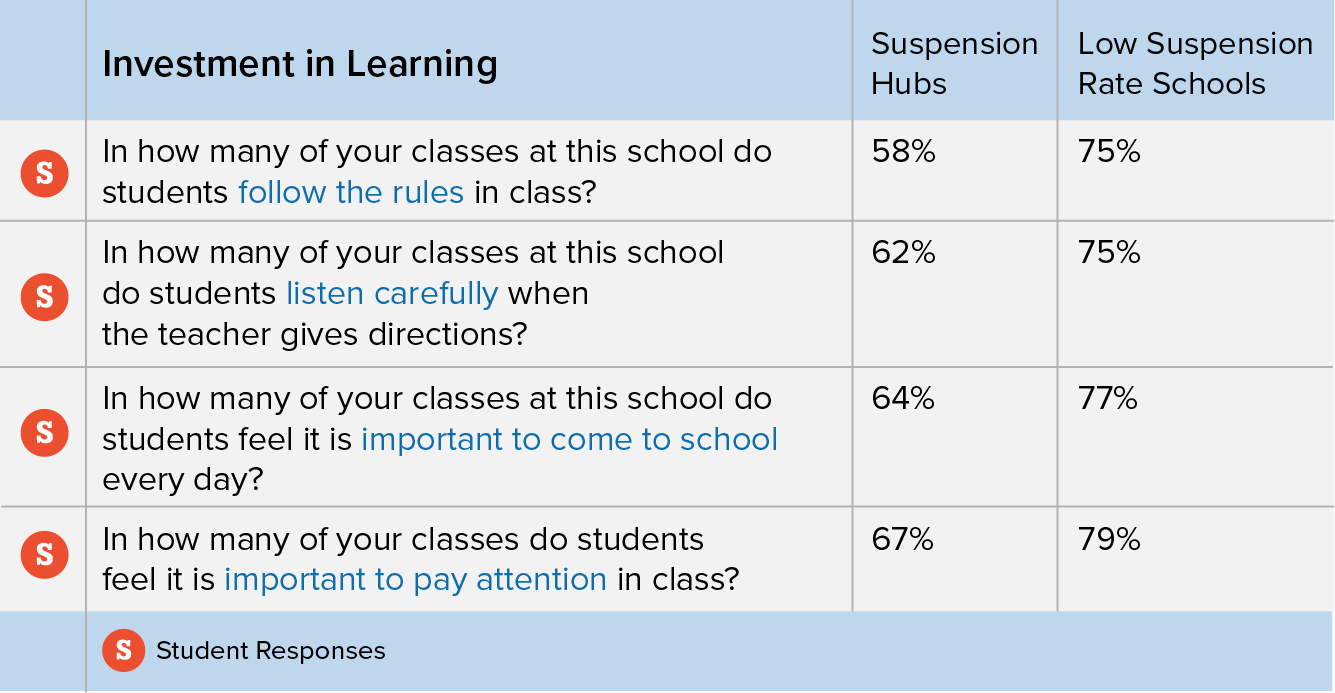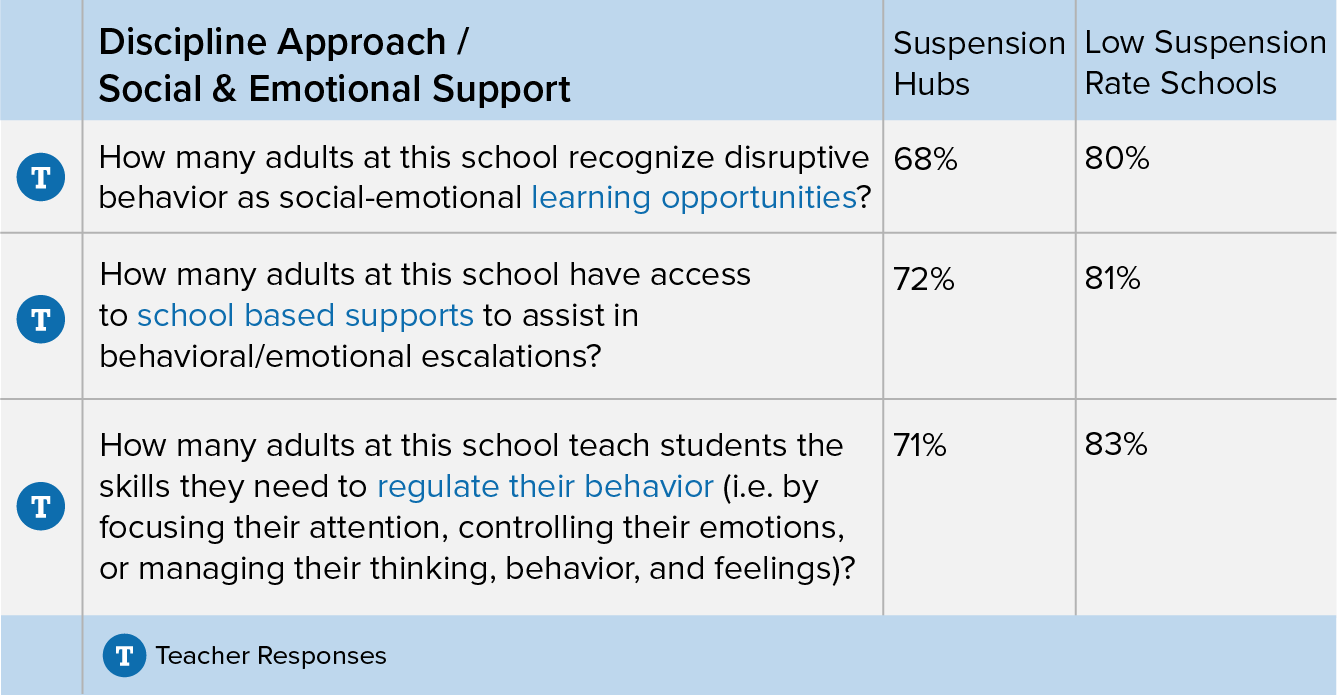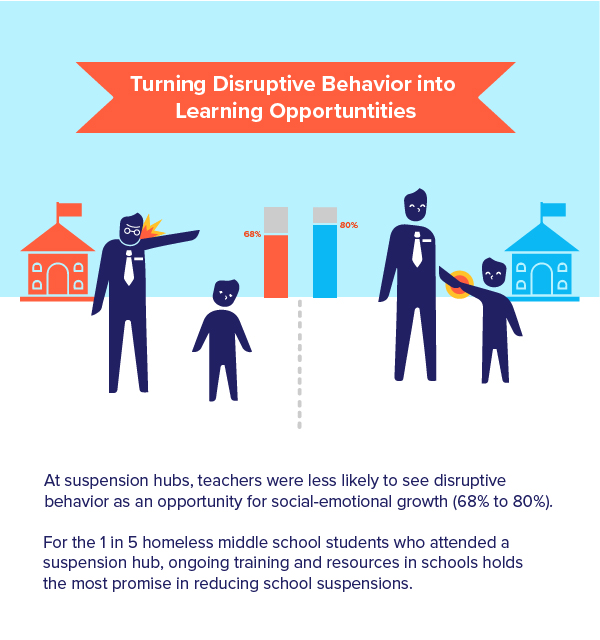A web supplement to Suspension Hubs: The Rise in Suspensions Among Homeless Students.
The New York City Department of Education (DOE) surveys parents, teachers, and students each year to gather information on a host of topics including school safety, investment in learning, and discipline approach. Responses indicate that there is a connection between school climate and suspension rates—the poorer the climate, the higher the suspension rate.
A school’s job is to create a safe place for students to learn. A teacher’s job is to foster student engagement in the learning process and grade level proficiency. A student’s job is to be prepared to learn and contribute to the school’s community. But what happens when behavior problems disrupt the classroom or school environment? The simple answer is to suspend the disruptive student—but how does this affect their learning? Teacher and student responses at middle school suspension hubs and schools with low suspension rates have some interesting insights about how a positive school climate may make a difference.
In schools with low suspension rates, nine out of ten teachers agreed that order and discipline are maintained, while in suspension hubs—schools with the highest suspension rates citywide—just seven out of ten teachers agreed (89% to 67%). Student responses also showed a similar pattern: over two-thirds of students attending middle schools with low suspension rates reported that their peers treated each other with respect compared to only 43% of students attending suspension hubs.

Suspensions not only result in students missing out on valuable learning time but can set back the learning process and cause students to become disengaged in school. In schools with higher suspension rates, survey results showed that students were less likely to follow directions (58%), listen to the teacher’s instructions (62%), and feel that attending school daily is important (64%) than at schools with low suspension rates.

Ensuring that schools and teachers have the tools and resources to effectively manage their classrooms is key to fostering school environments that are truly welcoming for all—including vulnerable students such as those experiencing homelessness who might act out due to experiences of family instability and trauma. Schools with low suspension rates were more likely to have additional school-based supports to assist teachers with behavioral or emotional escalations compared to teachers in suspension hubs. Specifically, 81% of teachers in low suspension schools reported access to these supports versus 72% of teachers in suspension hubs. Even further, 80% of teachers in schools with the lowest suspension rates recognized disruptive behavior as a social-emotional learning opportunity compared to only 68% of teachers in suspension hubs.


What Resources Exist to Promote Positive School Climates for Homeless Students?
Several schools throughout New York City are leading the charge in using positive alternatives to exclusionary practices such as suspensions to keep students in class and invest them further in learning. Given that homeless middle schoolers are more likely to experience violence, sleepless nights, and hunger before coming to class, a positive and trauma-informed school climate is imperative. Suspensions to homeless students in the class of 2015 alone could cost taxpayers an estimated $16 million or more—a price that can be avoided if investments in positive school climates are made. Highlighted are a few approaches that are already in use throughout the city as well as additional resources to support your school’s efforts in creating a positive school climate.
Social Emotional Learning:
Social emotional learning involves helping students to regulate their emotions, form positive peer relationships, and develop healthy self-esteem. The Collaborative for Academic, Social, and Emotional Learning defines social emotional learning using five key areas: self-awareness, self-management, social awareness, relationship skills, and responsible decision-making. This approach has been embraced by the Science and Technology Academy: A Mott Hall School. This middle school lies in the Bronx’s School District 9—the district with the highest concentration of homeless students in the entire city. More than 17% of students were homeless in SY 2015–16, yet the school had a low overall suspension rate (less than 1%). The school has invested in the social emotional learning of students for years, stating in 2012: “We have several service learning initiatives the support our students’ social and emotional learning. … We have identified 22 of our students who are most in need of emotional support based on data on discipline infractions. These students are assigned mentors who track progress and who is in constant communication with the students’ parents and guardians.”
Restorative Justice:
Restorative Justice is a practice that has gained widespread recognition as a replacement to harsh discipline practices. For homeless students who often experience trauma and are exposed to violence, addiction, and other damaging behaviors, this practice is critical. To learn more about school-wide restorative justice initiatives, explore the Brooklyn Restorative Justice Project’s “Lessons Learned About Early Implementation of Restorative Justice in Schools.” Last year, New York City Department of Education invested $500,000 in implementing Restorative Justice in all 35 schools in Brooklyn District 18. The ultimate goal was to transform school environments and reduce suspensions. In one District 18 school—the Middle School for Art and Philosophy—9% of students were suspended in SY 2015–16 compared to a citywide rate of 2.5%, making this a suspension hub. One-sixth of the student population was homeless (16% compared to 9% citywide). Their leadership team discussed implementing Restorative Justice in their most recent Comprehensive Educational Plan: “Student responses on the learning environment survey have been far lower on average than that of both teachers and parents. Yet, student[s] talk about feeling supported in our school. … As a result, the staff have identified the need to develop strong relationships with students and plans to incorporate restorative practices instructional program this year.”
Positive Behavior Intervention Supports:
Positive Behavior Intervention Supports (PBIS) is a system that schools can adopt that recognizes and rewards students for exhibiting positive behavior. This can help students experiencing homelessness to feel welcome and secure in school. Explore more on PBIS strategies in this 2014 policy brief from the National Education Association. At the X017 school, a District 75 Citywide Special Education school, 9% of students are homeless—equal to the citywide average—and 100% are special education students. Yet in SY 2015–16, only 6 suspensions were handed out to the entire student body and the school’s overall suspension rate was just 1%, less than half of the citywide rate of 2.5%. “X017 provides a supportive environment to students through a schoolwide PBIS system that clearly details expectations and reinforces positive behaviors, ensuring classroom environments that are welcoming, safe and orderly.” The school collects data to measure progress towards PBIS program goals, such as to “develop student structures to improve student ownership and peer to peer interactions.” By teaching, modeling, and rewarding positive behavior, PBIS allows teachers and school staff to take preventative steps in reducing negative behavior and fostering a more productive learning environment.
Note: Suspension Hubs are schools that suspended more than 6.6% of students overall during SY 2015–16. This was twice the citywide rate for homeless students (3.2%) and nearly three times the rate for all students (2.5%). Schools with low suspension rates suspended less than 1.1% of students.
Survey Data Source: New York City Department of Education, 2016 NYC School Survey, data tabulated by the Institute for Children, Poverty, and Homelessness, SY 2015–16.
Visit https://www.icphusa.org/SuspensionHubs for more information about Suspension Hubs. See how your school’s suspension rate ranks at https://www.icphusa.org/interactive_data/suspensionhubsmap.